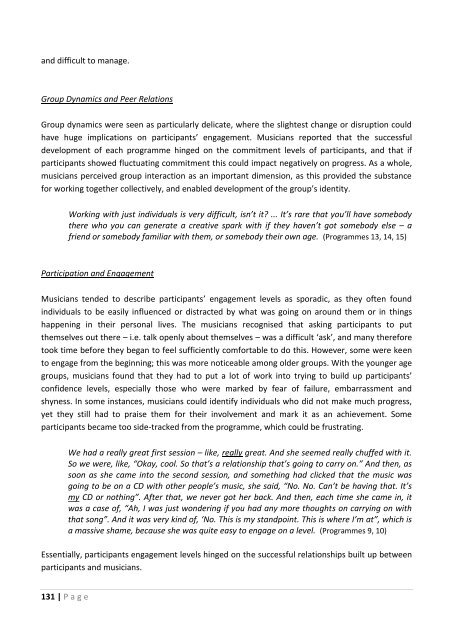De Viggiani, N., Daykin, N., Moriarty, Y. and Pilkington, P. and ...
De Viggiani, N., Daykin, N., Moriarty, Y. and Pilkington, P. and ...
De Viggiani, N., Daykin, N., Moriarty, Y. and Pilkington, P. and ...
You also want an ePaper? Increase the reach of your titles
YUMPU automatically turns print PDFs into web optimized ePapers that Google loves.
<strong>and</strong> difficult to manage.<br />
Group Dynamics <strong>and</strong> Peer Relations<br />
Group dynamics were seen as particularly delicate, where the slightest change or disruption could<br />
have huge implications on participants’ engagement. Musicians reported that the successful<br />
development of each programme hinged on the commitment levels of participants, <strong>and</strong> that if<br />
participants showed fluctuating commitment this could impact negatively on progress. As a whole,<br />
musicians perceived group interaction as an important dimension, as this provided the substance<br />
for working together collectively, <strong>and</strong> enabled development of the group’s identity.<br />
Working with just individuals is very difficult, isn’t it? ... It’s rare that you’ll have somebody<br />
there who you can generate a creative spark with if they haven’t got somebody else – a<br />
friend or somebody familiar with them, or somebody their own age. (Programmes 13, 14, 15)<br />
Participation <strong>and</strong> Engagement<br />
Musicians tended to describe participants’ engagement levels as sporadic, as they often found<br />
individuals to be easily influenced or distracted by what was going on around them or in things<br />
happening in their personal lives. The musicians recognised that asking participants to put<br />
themselves out there – i.e. talk openly about themselves – was a difficult ‘ask’, <strong>and</strong> many therefore<br />
took time before they began to feel sufficiently comfortable to do this. However, some were keen<br />
to engage from the beginning; this was more noticeable among older groups. With the younger age<br />
groups, musicians found that they had to put a lot of work into trying to build up participants’<br />
confidence levels, especially those who were marked by fear of failure, embarrassment <strong>and</strong><br />
shyness. In some instances, musicians could identify individuals who did not make much progress,<br />
yet they still had to praise them for their involvement <strong>and</strong> mark it as an achievement. Some<br />
participants became too side-tracked from the programme, which could be frustrating.<br />
We had a really great first session – like, really great. And she seemed really chuffed with it.<br />
So we were, like, “Okay, cool. So that’s a relationship that’s going to carry on.” And then, as<br />
soon as she came into the second session, <strong>and</strong> something had clicked that the music was<br />
going to be on a CD with other people’s music, she said, “No. No. Can’t be having that. It’s<br />
my CD or nothing”. After that, we never got her back. And then, each time she came in, it<br />
was a case of, “Ah, I was just wondering if you had any more thoughts on carrying on with<br />
that song”. And it was very kind of, ‘No. This is my st<strong>and</strong>point. This is where I’m at”, which is<br />
a massive shame, because she was quite easy to engage on a level. (Programmes 9, 10)<br />
Essentially, participants engagement levels hinged on the successful relationships built up between<br />
participants <strong>and</strong> musicians.<br />
131 | P a g e
















